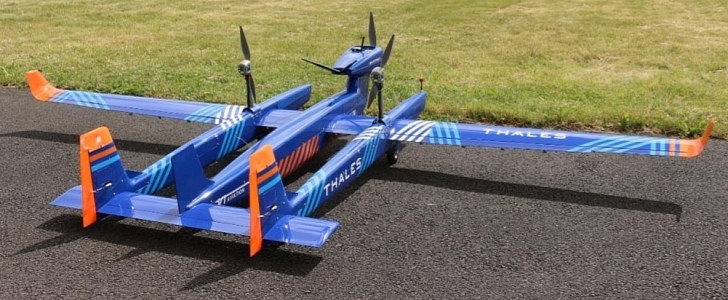Thales has completed the first flight of a half-scale prototype of its long-range drone. Dubbed the UAS 100, the prototype is designed to address the demand for more cost-effective drone operations with less environmental impact.
French company Thales has entered the drone game with its new autonomous aircraft. Built for infrastructure inspection, coastal surveillance, border surveillance, search-and-rescue, and military operations, the UAS100 is still in its prototype phase.
The UAS 100 program was born from a collaboration between aircraft manufacturer Issoire Aviation, which designed and constructed the drone, and avionics software company Hionos, whose expertise contributed to implementing the autopilot software solutions.
Combining Thales' approved standards of flight safety and security with the small weight and compact design, the aircraft is equipped with jam-resistant navigation technology that will ensure its safe operation even in case of electromagnetic interferences (EMI).
According to the Les Ailes du Quebec, the UAS 100 is powered by two electric motors as well as an internal combustion engine and has a flight time of five hours. It also uses radio, 4G, satellite communication and can even function in areas where the signal is poor. The final version of the aircraft will be capable of carrying a payload of 10 kg (22 lbs) and offer a range of over 100 km (62 miles).
Further testing will be carried out, with a full-scale model flying test expected to take place in 2022. Thales seeks to be certified by 2023 and fly outside urban areas with an operational altitude below 150 meters (492 ft) above ground.
The system, which has received support from the French Ministry of the Armed Forces through the Defence Innovation Agency (AID), aims to reduce drone operating costs and improve their environmental impact while also providing new options for inspection and surveillance missions and enhancing government and military capabilities.
The UAS 100 program was born from a collaboration between aircraft manufacturer Issoire Aviation, which designed and constructed the drone, and avionics software company Hionos, whose expertise contributed to implementing the autopilot software solutions.
Combining Thales' approved standards of flight safety and security with the small weight and compact design, the aircraft is equipped with jam-resistant navigation technology that will ensure its safe operation even in case of electromagnetic interferences (EMI).
According to the Les Ailes du Quebec, the UAS 100 is powered by two electric motors as well as an internal combustion engine and has a flight time of five hours. It also uses radio, 4G, satellite communication and can even function in areas where the signal is poor. The final version of the aircraft will be capable of carrying a payload of 10 kg (22 lbs) and offer a range of over 100 km (62 miles).
Further testing will be carried out, with a full-scale model flying test expected to take place in 2022. Thales seeks to be certified by 2023 and fly outside urban areas with an operational altitude below 150 meters (492 ft) above ground.
The system, which has received support from the French Ministry of the Armed Forces through the Defence Innovation Agency (AID), aims to reduce drone operating costs and improve their environmental impact while also providing new options for inspection and surveillance missions and enhancing government and military capabilities.






